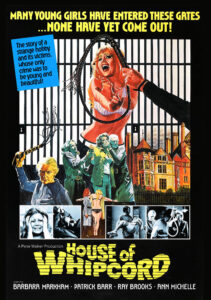HOUSE OF WHIPCORD **** UK 1974 Dir: Pete Walker. 102 mins
 The picture begins with an onscreen menacing warning over a thunderstorm.
The picture begins with an onscreen menacing warning over a thunderstorm.
“This film is dedicated to those who are disturbed by today’s lax moral codes and who eagerly await the return of corporal and capital punishment”.
While one can take the opening title with tongue firmly clamped in cheek there are those today that takes its meaning to heart. However, Pete Walker’s House Of Whipcord (1974) is simply a film made in those sleazy heady says of the ‘Video Nasties’.
Pete Walker who wrote the original story, directed and produced this gem of ‘Fetish’ cinema combining ‘Women in prison exploitation genre with some subtle social commentary on the British justice system. Walker is a controversial figure in the film along the line of his contemporary Michael Reeves. Reeves and Walker both use sadistic authority figures keying on the effect of those innocents caught up in their motives. House Of Whipcord (1974) opens chillingly with a storm and a lorry driver Jack (Ivor Salter) napping on the side of the road. A hand and face are barely visible in the rain slapping against his cabin glass causing him to open his door and let a female wayward traveler in. Jack questions her that she was left on a date etc. only to find she is in rough shape with bruises and whip marks on her back. Jack does the right thing and decides to take her to London. The story of how she got to the road unfolds in a flashback.
The film cuts to a 1970’s style Party with music and ‘live for today’s people. At the function is Ann-Marie Di Verney (Penny Irving) who is embarrassed when a partygoer unveils her posing nude in a public place. She seeks solace by meeting a charismatic stranger named Mark E. Desade (Robert Tayman) or as she puts it Mark E Du Sade. Di Verney is infatuated with her new lover and agrees to meet his parents. The telegraphed last name of Desade doesn’t connect with her even after the two play a party game that involves a suggested knife to her face. Upon the arrival of the British versions of The Last House On The Left and the others, Di Verney meets two middle-aged women, Walker and Bates (Sheila Keith and Dorothy Gordon) who appear to be prison guards. Di Verney is told to strip, to speak only when spoken to and tossed in a cell with an equally terrified woman. And indeed, it’s not long before the girl is thrust in front of Mark’s father, retired Justice Desmond Bailey (Patrick Barr) and his mother Mrs. Margaret Wakehurst (Barbara Markham) a prison warden dismissed for cruelty. These four individuals take it upon themselves to punish any young women whom they feel have escaped the law. Di Verney’s crime is that she posed naked. She is told that she will be made to be ashamed of her body.
Love him or hate him Producer/Director Pete Walker, does an excellent job in using the nightmarish prison interiors and exteriors. House Of Whipcord (1974) is well made for the budget and the time with some committed performances by all the cast. Penny Irving, who tries to speak in a French accent combined with the lustrous hair and wardrobe gives off a tang of Brigitte Bardot in La Vérité a 1960 French drama film directed by Henri-Georges Clouzot. Clouzot also explored relationships and fetishes in some of his work. Irving is no Bardot which is unfair, yet she tries hard running into the horrors of punishment at the hands of her sadistic jailers.
House Of Whipcord (1974) takes a cynical view of the justice system making the main Judge (Patrick Barr) blind and easily manipulated into signing death warrants for people whom he thinks he has helped. Toss in a character of the warden called Margaret Wakehurst which has similarities to former UK Prime Minister Margaret Thatcher.
Does this film work today? I think it does on a level of skill that Pete Walker shows as a Director. Walker knows filmmaking despite those that think his work is trash. The blood and gore are mostly implied except for one or two moments likely due to clashes with censors. One wonders if there is a restored version lurking in the forest. There is nudity and implied sex shown quite effectively by Penny Irving looking in total post-coital bliss with her hair dishevelled when Desade brings her home after an evening.
House Of Whipcord (1974) doesn’t age well as an exploitation film today with the advent of work like the original Martyrs (2008), the previously mentioned The Last House On The Left (1972) and countless others that border on crime films as opposed to horror. Pete Walker’s next film is equally odd, Frightmare (1974) with corpulent Rupert Davies in makeup and a hideous family secret. House Of Whipcord (1974) is good to see as an art piece of 1970’s standards by a maligned filmmaker who should be critically reexamined.
Review by Terry Sherwood

